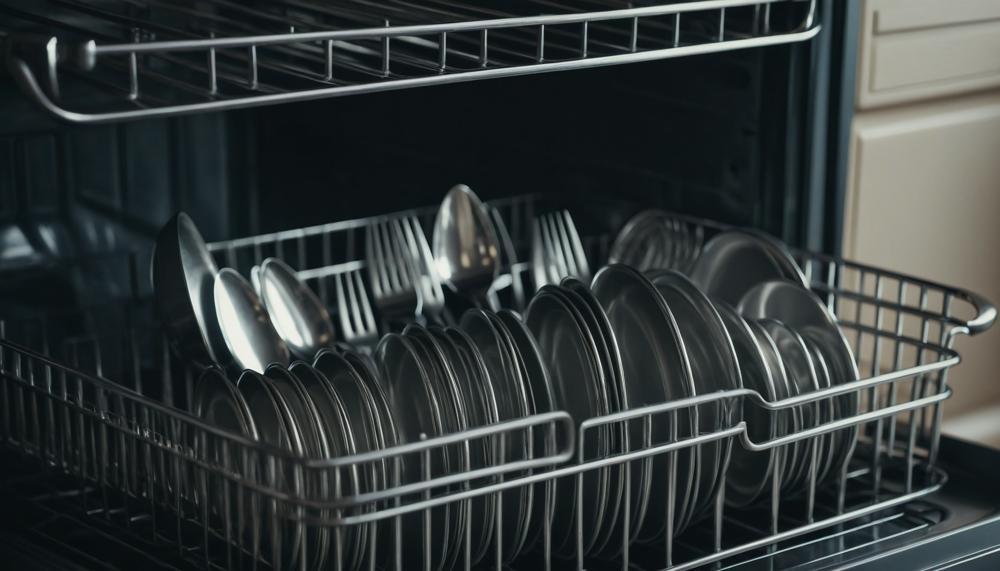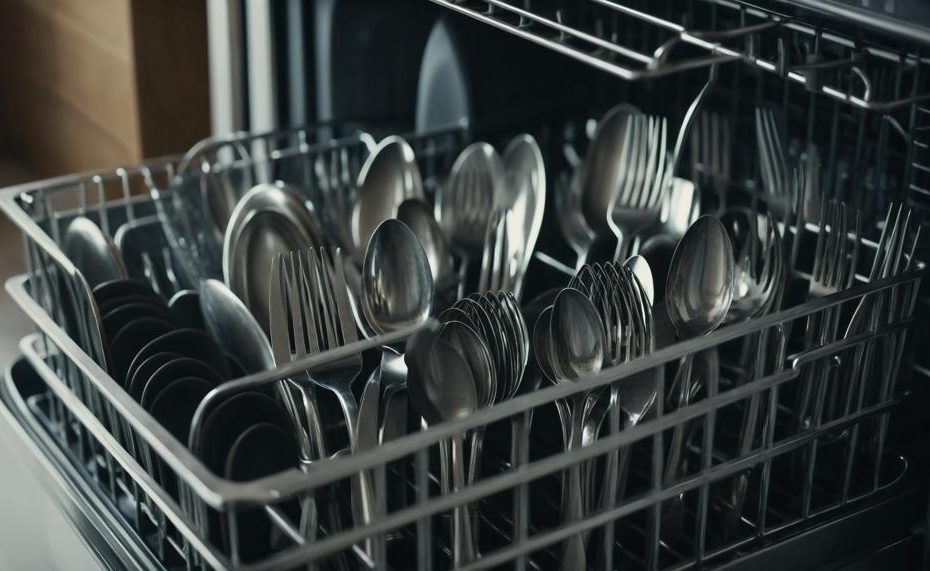Yes, you can wash silverware in a dishwasher without a basket. Simply place the silverware flat on the upper rack, making sure they are spread out evenly. This placement ensures they get exposed to the water spray for thorough cleaning. While this method works in a pinch, investing in a universal silverware basket is a game-changer for ease and efficiency.
Washing silverware in a dishwasher without a basket might sound tricky, but it’s completely doable with the right technique. Placing your forks, knives, and spoons flat on the upper rack not only prevents them from falling through the gaps but also maximizes their exposure to water jets, resulting in a sparkling clean.
While this method is a quick fix, consider getting a universal silverware basket that can attach inside your dishwasher for a more permanent solution. This basket not only keeps your silverware organized but also ensures optimal rinsing and protection during the wash cycle.
Key Takeaways:
- Lay silverware flat on the upper rack to ensure thorough cleaning.
- Spread out utensils to prevent them from clumping together.
- A universal silverware basket offers a long-term solution for better organization and protection.
- Placing silverware on the top rack minimizes the risk of damage.
- No need to hand-wash silverware if you use the upper rack method effectively.
By following these tips, you can maintain clean and shiny silverware even without a dedicated basket, ensuring your dishwasher runs smoothly and efficiently.
Contents
The Advantages of Cleaning Silverware in the Dishwasher
The advantages of cleaning silverware in the dishwasher compared to hand washing are numerous and impactful. Here’s a detailed breakdown:

| Aspect | Dishwasher | Hand Washing |
| Water and Energy Efficiency | Modern dishwashers are designed to use significantly less water and energy compared to hand washing. Dishwashers can save up to 5,000 gallons of water annually, making them more environmentally friendly. | Hand washing typically uses more water and energy, especially if the water is left running while scrubbing each item. |
| Cleaning Efficiency | Dishwashers provide thorough cleaning with powerful jets and high temperatures, ensuring that silverware is free from food particles, grease, and stains. | While hand washing can be effective, it often misses small particles and may not be as thorough in removing stubborn stains. |
| Sanitization | The high temperatures in dishwashers (typically reaching 140°F) kill bacteria and germs, ensuring that silverware is hygienically clean. | Hand washing usually involves lukewarm water, which is less effective at killing germs and bacteria. |
| Time and Effort | Using a dishwasher saves considerable time and effort, allowing users to simply load and unload the machine without the tedious task of scrubbing each item. | Hand washing is labor-intensive and time-consuming, requiring individual attention to each piece of silverware. |
| Safety | Dishwashers reduce the risk of cuts and injuries since there’s no need to handle sharp utensils or broken glassware frequently. | Hand washing involves direct contact with sharp utensils and potentially broken items, increasing the risk of injuries. |
| Kitchen Cleanliness | Dishwashers help maintain a cleaner kitchen by containing dirty dishes within a closed unit, reducing clutter and the spread of bacteria. | Hand washing often results in wet countertops and clutter, which can harbor bacteria and make the kitchen look untidy. |
| Handling Large Loads | Dishwashers are designed to efficiently handle large loads, making them more water and energy-efficient for big cleaning tasks. | Washing a large number of dishes by hand is cumbersome and less efficient, using more water and energy overall. |
Investing in a universal silverware basket for your dishwasher can further enhance cleaning efficiency and protect your utensils during the wash cycle. Utilizing the top rack for silverware when necessary ensures better water exposure and prevents damage.
Choosing the Right Dishwasher Cycle and Temperature
Different dishwasher cycles and temperature settings significantly impact the cleaning efficiency of silverware, especially when not using a basket. Here’s how:
| Cycle Type | Temperature | Effect on Cleaning |
| Normal Cycle | 120-140°F (49-60°C) | Provides a balanced approach, effectively removing typical food residues and stains. Best for everyday cleaning without causing damage. |
| Heavy Duty Cycle | 140-160°F (60-71°C) | Uses higher temperatures and longer wash times to tackle stubborn, baked-on food. Ideal for heavily soiled silverware but can risk tarnishing if used too frequently. |
| Light/Eco Cycle | 110-120°F (43-49°C) | Conserves energy and water, suitable for lightly soiled silverware. Less effective on tough stains but gentler on delicate pieces. |
| Sanitize Cycle | 150-160°F (65-71°C) | High temperatures kill bacteria and remove tough food residues. Excellent for deep cleaning but may not be suitable for all silverware due to the risk of heat damage. |
Tips for Optimal Cleaning
- Pre-Rinse: Remove large food particles to prevent clogging and ensure effective cleaning.
- Load Strategically: Without a basket, place silverware on the top rack, ensuring they don’t touch each other to avoid scratching and corrosion.
- Use Appropriate Detergents: Select gentle, phosphate-free detergents designed for silverware to avoid abrasive damage.
- Avoid Overloading: Ensure adequate spacing to allow water and detergent to reach all surfaces.
- Rinse Aids: Enhance the shine and prevent water spots.
Choosing the Right Dishwasher Detergent
The type of dishwasher detergent you should use to effectively clean silverware without a basket is one that is free from lemon, citrus, and phosphates. An excellent choice is Cascade Complete, which is specifically designed to be phosphate-free and does not contain lemon or citrus additives. This ensures your silverware is cleaned effectively without risk of corrosion or damage.
Here’s a detailed breakdown of the considerations and tips for using the right detergent:
| Detergent Feature | Importance | Recommendation |
| Phosphate-Free | Prevents environmental harm and avoids abrasive damage to silverware. | Cascade Complete |
| No Lemon/Citrus | Lemon and citrus can corrode and tarnish silverware over time. | Avoid detergents with these ingredients to maintain the longevity and shine of your silverware. |
| Rinse Aid Compatible | Enhances drying and prevents water spots, crucial for sparkling silverware. | Use in conjunction with a rinse aid like Finish Rinse Aid. |
Explanation: Silverware, especially without a basket, is more exposed to the washing process. Therefore, using a detergent like Cascade Complete that is phosphate-free and free of lemon or citrus additives is essential. Phosphates can be too abrasive, and citrus can cause tarnishing. Ensuring your detergent meets these criteria will help maintain your silverware’s pristine condition and effectiveness over time.
Post-Cleaning Silverware Care
After washing silverware in the dishwasher without a basket, it’s vital to ensure they are properly dried and stored to maintain their condition and prevent damage. Here are some expert tips:
- Immediate Drying: As soon as the dishwasher cycle finishes, remove the silverware promptly. This prevents water spots and reduces the risk of tarnishing.
- Use a Soft Cloth: Dry each piece with a soft, lint-free cloth to avoid scratches. Microfiber cloths are excellent for this purpose, as they are gentle and absorbent.
- Air Drying: If you prefer air drying, place the silverware on a clean, dry towel in a single layer, ensuring they don’t touch each other to avoid scratches.
- Proper Storage:
- Tarnish-Resistant Pouches: Store silverware in tarnish-resistant flannel or cloth pouches. These materials help protect against air and moisture, which can cause tarnishing.
- Avoid Wood: Do not store silverware directly on wooden surfaces as the acids and chemicals in wood can cause tarnishing.
- Dry Environment: Choose a dry storage location to prevent moisture buildup, which can accelerate tarnishing.
- Regular Polishing: Use a non-abrasive silver polish periodically to keep your silverware shiny and free from tarnish.
Conclusion
Washing silverware in a dishwasher without a basket can be seamlessly integrated into your routine with a few simple adjustments. By placing your utensils flat on the upper rack, you ensure maximum exposure to water jets, which guarantees a thorough clean. Spreading them out evenly prevents clumping, allowing each piece to be meticulously cleaned. This method, while effective in the short term, can be improved by investing in a universal silverware basket. This accessory keeps your silverware organized and optimally positioned for the wash cycle, enhancing both efficiency and protection.
Moreover, cleaning silverware in a dishwasher offers significant advantages over hand washing. Modern dishwashers are designed to be water and energy-efficient, saving up to 5,000 gallons of water annually. They provide superior cleaning through powerful jets and high temperatures, ensuring that even the toughest food residues are removed. Additionally, dishwashers sanitize effectively by reaching temperatures that kill bacteria, offering a level of cleanliness that hand washing typically cannot achieve.
To optimize your dishwasher’s performance without a basket, choose the appropriate cycle and temperature settings. Pre-rinse utensils to remove large food particles, use gentle, phosphate-free detergents, and avoid overloading to ensure adequate spacing.





